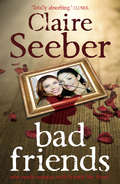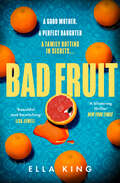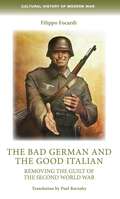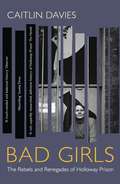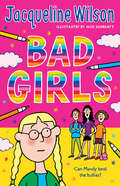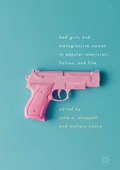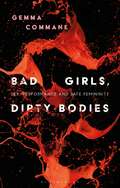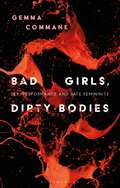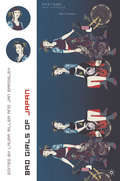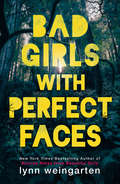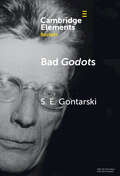- Table View
- List View
Bad Form: Social Mistakes and the Nineteenth-Century Novel
by Kent PuckettWhat--other than embarrassment--could one hope to gain from prolonged exposure to the social mistake? Why think much about what many would like simply to forget? In Bad Form: Social Mistakes and the Nineteenth-Century Novel, Kent Puckett argues that whatever its awkwardness, the social mistake-the blunder, the gaffe, the faux pas-is a figure of critical importance to the nineteenth-century novel. While offering significant new readings of Thackeray, Flaubert, Eliot, James, and others, Puckett shows how the classic realist novel achieves its coherence thanks to minor mistakes that novels both represent and make. While uncovering the nineteenth-century novel's persistent social and structural reliance on the non-catastrophic mistake-eating peas with your knife, saying the wrong thing, overdressing-Bad Form argues that the novel's once considerable cultural authority depends on what we might otherwise think of as that authority's opposite: a jittery, anxious, obsessive attention to the mistakes of others that is its own kind of bad form. Drawing on sociology, psychoanalysis, narrative theory, and the period's large literature on etiquette, Puckett demonstrates that the nineteenth-century novel relies for its form on the paradoxical force of the social mistake.
Bad Form: Social Mistakes and the Nineteenth-Century Novel
by Kent PuckettWhat--other than embarrassment--could one hope to gain from prolonged exposure to the social mistake? Why think much about what many would like simply to forget? In Bad Form: Social Mistakes and the Nineteenth-Century Novel, Kent Puckett argues that whatever its awkwardness, the social mistake-the blunder, the gaffe, the faux pas-is a figure of critical importance to the nineteenth-century novel. While offering significant new readings of Thackeray, Flaubert, Eliot, James, and others, Puckett shows how the classic realist novel achieves its coherence thanks to minor mistakes that novels both represent and make. While uncovering the nineteenth-century novel's persistent social and structural reliance on the non-catastrophic mistake-eating peas with your knife, saying the wrong thing, overdressing-Bad Form argues that the novel's once considerable cultural authority depends on what we might otherwise think of as that authority's opposite: a jittery, anxious, obsessive attention to the mistakes of others that is its own kind of bad form. Drawing on sociology, psychoanalysis, narrative theory, and the period's large literature on etiquette, Puckett demonstrates that the nineteenth-century novel relies for its form on the paradoxical force of the social mistake.
A Bad Fox (Read Write Inc. Phonics, Set 2, Purple) (PDF)
by Ruth Miskin Tim Archbold Gill MuntonThe Read Write Inc. Phonics storybooks provide structured practice in decoding words and reading through phonics. Each set of books is carefully graded so that children can read them with confidence, as soon as they have learned the sounds linked to the set. There are seven sets of books ,with 10-13 books in each set.
Bad Friends
by Claire SeeberA terrible accident. A secret discovered. An inescapable nightmare. Who needs enemies with friends like these? The unnerving new novel from the acclaimed author of LULLABY
Bad Fruit
by Ella KingEVERY FAMILY HAS ITS SECRETS . . .‘Unforgettable’ RED – ‘Memorable’ OBSERVER – ‘A family overflowing with secrets’ LOUISE HARE – ‘Impossible to put down’ CHRIS WHITAKER – ‘Searing’ ELLE – ‘A chilling literary thriller’ GRAZIA
The bad German and the good Italian: Removing the guilt of the Second World War (Cultural History of Modern War)
by Filippo FocardiIn the Axis War on the side of Germany, Mussolini's Italy was responsible for serious war crimes, especially in Yugoslavia and Greece. This 'dark side' of the fascist war, however, is not present in the national memory built after 1945. To distinguish Italy from the former German ally and avoid a punitive peace, the monarchist and anti-fascist ruling classes elaborated a master narrative that highlighted the opposition of the Italian people to Mussolini's war and the humanitarian behavior of Italian soldiers, depicted as saviors of Jews. All responsibility for the crimes committed in the Axis war was placed on the shoulders of the Germans, who thus became a convenient alibi for the national conscience.
The bad German and the good Italian: Removing the guilt of the Second World War (Cultural History of Modern War)
by Filippo FocardiIn the Axis War on the side of Germany, Mussolini's Italy was responsible for serious war crimes, especially in Yugoslavia and Greece. This 'dark side' of the fascist war, however, is not present in the national memory built after 1945. To distinguish Italy from the former German ally and avoid a punitive peace, the monarchist and anti-fascist ruling classes elaborated a master narrative that highlighted the opposition of the Italian people to Mussolini's war and the humanitarian behavior of Italian soldiers, depicted as saviors of Jews. All responsibility for the crimes committed in the Axis war was placed on the shoulders of the Germans, who thus became a convenient alibi for the national conscience.
Bad Girl
by Roberta KrayThe Quinns are one of the most feared criminal gangs in London's East End.So the reaction of Joe Quinn to the news that his daughter Lynsey is involved with a policeman is predictable and swift, and a pregnant Lynsey finds herself out on the street, bruised and alone.At the age of eleven, Lynsey's daughter Helen is returned to the clan. Hated by her grandfather, loved only by her uncle, she struggles to fit into a world she doesn't understand. As warring factions battle for control of the East End, tragedy is about to strike again.How can Helen survive? And who can she trust when the Quinn family's criminal past comes back to haunt her?
The Bad Girl: A Novel
by Mario Vargas LlosaRicardo Somocurcio is in love with a bad girl. He loves her as a teenager known as 'Lily' in Lima in 1950, where she claims to be from Chile but vanishes the moment her claim is exposed as fiction. He loves her next in Paris as 'Comrade Arlette', an activist en route to Cuba, an icy, remote lover who denies knowing anything about the Lily of years gone by. Whoever the bad girl turns up as and however poorly she treats him, Ricardo is doomed to worship her. Gifted liar and irresistible, maddening muse - does Ricardo ever know who she really is?
Bad Girl Reputation: an addictive second chance romance from the TikTok sensation
by Elle KennedyReturn to Avalon Bay in this sexy second chance story about two exes who can't stay away from each other . . . When former bad girl Genevieve West returns home for her mother's funeral, she's prepared to keep her distance from her ex-boyfriend, Evan Hartley. Their history is rife with turbulence. And passion. A heck of a lot of passion . . . which she's trying desperately to forget.But it's impossible not to run into Evan in the small coastal town where they once ran wild. And the moment she sees her gorgeous ex again, it's clear to Gen that Evan is still as unruly, sexy and irresistible as ever. This time around, however, she's resolved to walk a new path. No more partying. No more foolish mistakes. Her plan is to temporarily remain in town to help her father run his business, but the second he finds somebody else, she's out of there.Evan has other ideas. He knows they can be good together, but he just has to convince Genevieve of that, even if it means turning over a new leaf himself. But can a bad reputation ever truly be shed? Do second chances really work? Genevieve and Evan are about to find out.Why readers love Avalon Bay:'Delicious, complicated and drama-filled. . . I read it in one sitting, and you will, too' L. J. Shen, USA Today bestselling author'A deliciously sexy story with a wallop of emotions that sneaks up on you' Vi Keeland, No.1 New York Times bestselling author'Elle Kennedy delivers another sexy and addictive read, and my latest personal favourite from her!' Tijan, New York Times bestselling author'With plenty of steam alongside the youthful romance, this winsome story about following one's heart will especially appeal to hopeless romantics' Publishers Weekly
Bad Girls: A History of Rebels and Renegades
by Caitlin DaviesLONGLISTED FOR THE 2019 ORWELL PRIZE FOR POLITICAL WRITING'Davies's absorbing study serves up just enough sensationalism - and eccentricity - along with its serious inquiry' SUNDAY TIMES'[A] revealing account of the jail's 164-year history' DAILY TELEGRAPH, 5* review'Insightful and thought-provoking and makes for a ripping good read' JEREMY CORBYN'A much-needed and balanced history' OBSERVER'Davies explores how society has dealt with disobedient women - from suffragettes to refugees to women seeking abortions - for decades, and how they've failed to silence those who won't go down without a fight' STYLISTSociety has never known what to do with its rebellious women. Those who defied expectations about feminine behaviour have long been considered dangerous and unnatural, and ever since the Victorian era they have been removed from public view, locked up and often forgotten about. Many of these women ended up at HM Prison Holloway, the self-proclaimed 'terror to evil-doers' which, until its closure in 2016, was western Europe's largest women's prison. First built in 1852 as a House of Correction, Holloway's women have come from all corners of the UK - whether a patriot from Scotland, a suffragette from Huddersfield, or a spy from the Isle of Wight - and from all walks of life - socialites and prostitutes, sporting stars and nightclub queens, refugees and freedom fighters. They were imprisoned for treason and murder, for begging, performing abortions and stealing clothing coupons, for masquerading as men, running brothels and attempting suicide. In Bad Girls, Caitlin Davies tells their stories and shows how women have been treated in our justice system over more than a century, what crimes - real or imagined - they committed, who found them guilty and why. It is a story of victimization and resistance; of oppression and bravery. From the women who escaped the hangman's noose - and those who didn't - to those who escaped Holloway altogether, Bad Girls is a fascinating look at how disobedient and defiant women changed not only the prison service, but the course of history.
Bad Girls ((adaptation) Ser.)
by Jacqueline Wilson Nick SharrattShy, mild Mandy has been bullied at school for as long as she can remember. That's why she is delighted when cheeky, daring, full-of-fun Tanya picks her as a friend. Mum isn't happy - she thinks Tanya's a BAD GIRL and a bad influence on her daughter. But Mandy loves spending time with her brilliant new friend, and is sure Tanya can only get her out of trouble, not into it . . . or could she?
Bad Girls and Transgressive Women in Popular Television, Fiction, and Film
by Julie A. Chappell Mallory YoungThis collection of essays focuses on the representations of a variety of “bad girls”—women who challenge, refuse, or transgress the patriarchal limits intended to circumscribe them—in television, popular fiction, and mainstream film from the mid-twentieth century to the present. Perhaps not surprisingly, the initial introduction of women into Western cultural narrative coincides with the introduction of transgressive women. From the beginning, for good or ill, women have been depicted as insubordinate. Today’s popular manifestations include such widely known figures as Lisbeth Salander (the “girl with the dragon tattoo”), The Walking Dead’s Michonne, and the queen bees of teen television series. While the existence and prominence of transgressive women has continued uninterrupted, however, attitudes towards them have varied considerably. It is those attitudes that are explored in this collection. At the same time, these essays place feminist/postfeminist analysis in a larger context, entering into ongoing debates about power, equality, sexuality, and gender.
Bad Girls and Transgressive Women in Popular Television, Fiction, and Film
by Julie A. Chappell Mallory YoungThis collection of essays focuses on the representations of a variety of “bad girls”—women who challenge, refuse, or transgress the patriarchal limits intended to circumscribe them—in television, popular fiction, and mainstream film from the mid-twentieth century to the present. Perhaps not surprisingly, the initial introduction of women into Western cultural narrative coincides with the introduction of transgressive women. From the beginning, for good or ill, women have been depicted as insubordinate. Today’s popular manifestations include such widely known figures as Lisbeth Salander (the “girl with the dragon tattoo”), The Walking Dead’s Michonne, and the queen bees of teen television series. While the existence and prominence of transgressive women has continued uninterrupted, however, attitudes towards them have varied considerably. It is those attitudes that are explored in this collection. At the same time, these essays place feminist/postfeminist analysis in a larger context, entering into ongoing debates about power, equality, sexuality, and gender.
Bad Girls, Dirty Bodies: Sex, Performance and Safe Femininity (Library of Gender and Popular Culture)
by Gemma CommaneWhat makes a woman 'bad' is commonly linked to certain 'qualities' or behaviours seen as morally or socially corrosive, dirty and disgusting. In Bad Girls, Dirty Bodies, Gemma Commane critically explores the social, sexual and political significance of women who are labelled 'bad', sluts or dirty. Through a variety of case studies drawn from qualitative and original ethnographic research, she argues that 'Bad Girls' disrupt heterosexual normativity and contribute new embodied knowledge.From neo-burlesque, sex-positive and queer performance art, to explicit entertainment and areas of popular culture; Commane situates 'bad' women as sites of power, possibility and success. Through the combination of case studies (Ms T, Empress Stah and RubberDoll, Mouse and Doris La Trine), Gemma Commane offers a challenge to those who think that sexual, slutty, bad, and dirty women are not worth listening to. Significantly, she unpicks the issues generated by women who are complicit in the subjugation, policing and marginalization of 'other' women, both in popular culture and in sites of subcultural resistance.
Bad Girls, Dirty Bodies: Sex, Performance and Safe Femininity (Library of Gender and Popular Culture)
by Gemma CommaneWhat makes a woman 'bad' is commonly linked to certain 'qualities' or behaviours seen as morally or socially corrosive, dirty and disgusting. In Bad Girls, Dirty Bodies, Gemma Commane critically explores the social, sexual and political significance of women who are labelled 'bad', sluts or dirty. Through a variety of case studies drawn from qualitative and original ethnographic research, she argues that 'Bad Girls' disrupt heterosexual normativity and contribute new embodied knowledge.From neo-burlesque, sex-positive and queer performance art, to explicit entertainment and areas of popular culture; Commane situates 'bad' women as sites of power, possibility and success. Through the combination of case studies (Ms T, Empress Stah and RubberDoll, Mouse and Doris La Trine), Gemma Commane offers a challenge to those who think that sexual, slutty, bad, and dirty women are not worth listening to. Significantly, she unpicks the issues generated by women who are complicit in the subjugation, policing and marginalization of 'other' women, both in popular culture and in sites of subcultural resistance.
Bad Girls Go Everywhere: Wisdom, Humor, and Inspiration from Women with Attitude
by Ross Petras Kathryn PetrasWomen with attitude; chicks with balls; and spirited females who proudly own the word "bitches.” Bad Girls Go Everywhere is a collection of 300 kick-ass quotes with words of wisdom, inspiration, humor, and sass from past and present-day women who aren't afraid to tell it like it is. From Queen Victoria to Queen Latifah, from Bette Davis to Betty White, and from Maria Callas to Mindy Kaling, the fun females in this book comment on everything from body image, truth, and self-actualization to men, relationships, and work. Also included are 50 full-color and black-and-white images throughout.
Bad Girls Good Women: Strangers, Bad Girls Good Women, A Woman Of Our Times, All My Sins Remembered
by Rosie ThomasFrom the bestselling author of The Kashmir Shawl
Bad Girls in School (Caribbean Modern Classics)
by Gwyneth HaroldThere have been many great and enduring works of literature by Caribbean authors over the last century. The Caribbean Contemporary Classics collection celebrates these deep and vibrant stories, overflowing with life and acute observations about society.Three girls are on the brink of expulsion from the respected Redeemer College: 'Failure to complete term assignments, ... using foul language ... stealing another student's cell phone ... persistent lateness for English classes. Breaching the behaviour code ...' Katreena, Ta Jeeka and Caledonia are about to be written off. This insightful book unsentimentally exposes the fault lines through society, and the deep effects they have on individuals. It describes the choices people make and the decisions they feel forced in to. Maturing into young adulthood, these girls each have to make, or lose, their way, in their own way. What difference can one teacher make?
Bad Girls in School (Caribbean Modern Classics)
by Gwyneth HaroldThere have been many great and enduring works of literature by Caribbean authors over the last century. The Caribbean Contemporary Classics collection celebrates these deep and vibrant stories, overflowing with life and acute observations about society.Three girls are on the brink of expulsion from the respected Redeemer College: 'Failure to complete term assignments, ... using foul language ... stealing another student's cell phone ... persistent lateness for English classes. Breaching the behaviour code ...' Katreena, Ta Jeeka and Caledonia are about to be written off. This insightful book unsentimentally exposes the fault lines through society, and the deep effects they have on individuals. It describes the choices people make and the decisions they feel forced in to. Maturing into young adulthood, these girls each have to make, or lose, their way, in their own way. What difference can one teacher make?
Bad Girls Never Say Die
by Jennifer MathieuEvie Barnes is a bad girl. And everyone knows that bad girls make the best friends... A story of murder, secrets and tragedy from the author of MOXIE - as seen on Netflix.1964. Houston, Texas.Evie Barnes is a 'bad' girl. So are all her friends. They're the sort who wear bold makeup, laugh too loud and run around with boys. Most of all, they protect their own against the world. So when Evie is saved from being assaulted by a good girl from the right side of the tracks, every rule she's always lived by is called into question. Now she must rethink everything she knew about loyalty and learn that when girls stick together it doesn't matter whether they're 'good' or 'bad'.In this riveting story of murder, secrets, and tragedy, Jennifer Mathieu reimagines S. E. Hinton's The Outsiders from a female perspective. Bad Girls Never Say Die has all the drama and heartache of that teen classic, but with a feminist take just right for our times.
Bad Girls of Ancient Greece: Myths and Legends from the Baddies that Started it all
by null Lizzy TiffinYou’ve heard all about the ‘brilliant men’ of ancient myth, but what about the scheming and scandalous women who were so often lost in their shadow? Bad Girls of Ancient Greece contains profiles of wayward wives, mad mothers, scandalous sisters and damsels, that quite frankly, caused others A LOT of stress in the ancient world. With the ever-growing popularity of mythological retellings, Lizzy Tiffin has written THE guide to all of the baddies of ancient Greece. This book stands as a reminder that us women really have been bad – in the best way possible – from the start. Written with humour and sass, Lizzy profiles the women in Greek myth and legend covering: mortals, goddesses, titans, nymphs (you name it, she’s done it). Here you’ll find the weird and wonderful escapades of the women we’re often lead to believe were minor characters. Bad Girls of Ancient Greece is an accessible, intelligent, hilarious (sometimes spicy) guide to the women we love and know – Athena, Medusa, Aphrodite – and also those we may not, like Polyphonte, who was cursed with burning hot lust for a wild bear … imagine! So dive into the stories you thought you knew with Bad Girls of Ancient Greece as your illuminating guide…
Bad Girls of Japan
by L. Miller J. BardsleyAre bad girls casualties of patriarchy, a necessary evil, or visionary pioneers? The authors in this volume propose shifts in our perceptions of bad girls by providing new ways to understand them through the case of Japan. By tracing the concept of the bad girl as a product of specific cultural assumptions and historical settings, Bad Girls of Japan maps new roads and old detours in revealing a disorderly politics of gender. Bad Girls of Japan explores deviancy in richly diverse media: mountain witches, murderers, performance artists, cartoonists, schoolgirls and shoppers gone wild are all part of the terrain.
Bad Girls with Perfect Faces
by Lynn WeingartenSTUNNING NEW PSYCHOLOGICAL THRILLER FROM THE AUTHOR OF THE NEW YORK TIMES BESTSELLER SUICIDE NOTES FROM BEAUTIFUL GIRLS.
Bad Godots: ‘Vladimir Emerges from the Barrel' and Other Interventions (Elements in Beckett Studies)
by null S. E. GontarskiThis Element focuses on the machinery of commercial theatre, on extra-authorial interventions into the creative process and on the people and institutional forces that foster them. Such a process challenges the autonomy of the artwork and authorial integrity. The primary focus of this Element is then on the hybrid genre of theatre where collective esthetics tends to override and so to supersede individual creation. The essay pays special attention to Samuel Beckett's first professionally produced play, Waiting for Godot, primarily its English language premieres in the US, UK, and the Republic of Ireland. Its implications, however, reach far beyond the genetic and production histories of a single theatrical work to deal with the nature of authorship in a monetized culture, the process of realizing dramatic texts in such a culture, and Samuel Beckett's engagement with such machinery of art.


